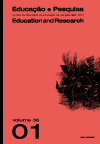The invention of the Émile as conjecture: methodological choice of Rousseau's writing
DOI:
https://doi.org/10.1590/S1517-97022010000100002Keywords:
Education, Émile, Rousseau, Philosophy of education, EnlightenmentAbstract
The present work aims at a reflection on Rousseau's pedagogical thinking. To such end, the analysis is centered on the reading of his Émile: or treatise on education published in 1762. The article seeks to contrast the Émile with the analyses of commentators, so as to proceed to a literature review on the subject. The hypothesis put forward here is that the Émile is more than just a book about education. Rousseau emphasizes in his text his concern with establishing a characterization of the child's "being". In this sense he was trying to find in childhood in general vestiges of the man in a state of Nature. In so doing, he establishes a periodization of life and of learning. Denouncing the neglect displayed by his epoch with regard to the child, and critical of the educational model propagated by the religious schools of that time, Rousseau describes the condition of the child, whilst inventing an imaginary boy that was supposed to be educated according to Nature's criteria. Émile's education can be understood as a libel against the harshness of the treatment dispensed to real children - both inside their families and at school. According to the philosopher people were incapable of "seeing" the child. Therefore, the writing of the Émile does not intend to establish pedagogical prescriptions, since Rousseau has the boy educated away from society. The objective here is a different one: the author wanted to identify in the child his essence. The figure of Émile is, thus, a method to operate the thought.Downloads
Download data is not yet available.
Downloads
Published
2010-04-01
Issue
Section
Articles
License
Authors assume exclusive responsibility for the concepts expressed in their articles, which do not necessarily reflect the journal’s opinion.
Permission to photocopy all or part of the material published in the journal is granted provided that the original source of publication be assigned.
How to Cite
The invention of the Émile as conjecture: methodological choice of Rousseau’s writing . (2010). Educação E Pesquisa, 36(1), 207-225. https://doi.org/10.1590/S1517-97022010000100002



